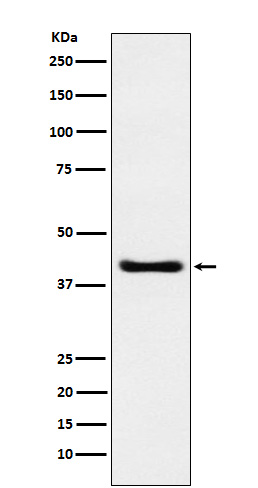SPOP Antibody
Rabbit mAb
- SPECIFICATION
- CITATIONS
- PROTOCOLS
- BACKGROUND

Application
| WB |
|---|---|
| Primary Accession | O43791 |
| Clonality | Monoclonal |
| Other Names | BTBD32; SPOP; TEF2; |
| Isotype | Rabbit IgG |
| Host | Rabbit |
| Calculated MW | 42132 Da |
| Dilution | WB 1:500~1:1000 |
|---|---|
| Purification | Affinity-chromatography |
| Immunogen | A synthesized peptide derived from human SPOP |
| Description | Inhibits IPF1/PDX1 transactivation of established target promoters, such as insulin, may be by recruiting a repressor complex (By similarity). In complex with CUL3, involved in ubiquitination of BMI1, H2AFY and DAXX, and probably also in ubiquitination and proteasomal degradation of Gli2 or Gli3. |
| Storage Condition and Buffer | Rabbit IgG in phosphate buffered saline , pH 7.4, 150mM NaCl, 0.02% sodium azide and 50% glycerol. Store at +4°C short term. Store at -20°C long term. Avoid freeze / thaw cycle. |
| Name | SPOP (HGNC:11254) |
|---|---|
| Function | Component of a cullin-RING-based BCR (BTB-CUL3-RBX1) E3 ubiquitin-protein ligase complex that mediates the ubiquitination of target proteins, leading most often to their proteasomal degradation. In complex with CUL3, involved in ubiquitination and proteasomal degradation of BRMS1, DAXX, PDX1/IPF1, GLI2 and GLI3. In complex with CUL3, involved in ubiquitination of MACROH2A1 and BMI1; this does not lead to their proteasomal degradation. Inhibits transcriptional activation of PDX1/IPF1 targets, such as insulin, by promoting PDX1/IPF1 degradation. The cullin-RING-based BCR (BTB-CUL3-RBX1) E3 ubiquitin-protein ligase complex containing homodimeric SPOP has higher ubiquitin ligase activity than the complex that contains the heterodimer formed by SPOP and SPOPL. Involved in the regulation of bromodomain and extra-terminal motif (BET) proteins BRD2, BRD3, BRD4 stability (PubMed:32109420). Plays an essential role for proper translation, but not for their degradation, of critical DNA replication licensing factors CDT1 and CDC6, thereby participating in DNA synthesis and cell proliferation (PubMed:36791496). Regulates interferon regulatory factor 1/IRF1 proteasomal turnover by targeting S/T-rich degrons in IRF1 (PubMed:37622993). Facilitates the lysosome-dependent degradation of enterovirus EV71 protease 2A by inducing its 'Lys-48'- linked polyubiquitination, which ultimately restricts EV71 replication (PubMed:37796126). Acts as an antiviral factor also against hepatitis B virus/HBV by promoting ubiquitination and subsequent degradation of HNF1A (PubMed:38018242). In turn, inhibits HBV transcription and replication by preventing HNF1A stimulating activity of HBV preS1 promoter and enhancer II (PubMed:38018242). Involved in ubiquitination of BRDT and promotes its degradation, thereby regulates histone removal in early condensing spermatids prior to histone-to-protamine exchange (By similarity). |
| Cellular Location | Nucleus. Nucleus speckle Cytoplasm |
| Tissue Location | Widely expressed.. |

Thousands of laboratories across the world have published research that depended on the performance of antibodies from Abcepta to advance their research. Check out links to articles that cite our products in major peer-reviewed journals, organized by research category.
info@abcepta.com, and receive a free "I Love Antibodies" mug.
Provided below are standard protocols that you may find useful for product applications.
If you have used an Abcepta product and would like to share how it has performed, please click on the "Submit Review" button and provide the requested information. Our staff will examine and post your review and contact you if needed.
If you have any additional inquiries please email technical services at tech@abcepta.com.













 Foundational characteristics of cancer include proliferation, angiogenesis, migration, evasion of apoptosis, and cellular immortality. Find key markers for these cellular processes and antibodies to detect them.
Foundational characteristics of cancer include proliferation, angiogenesis, migration, evasion of apoptosis, and cellular immortality. Find key markers for these cellular processes and antibodies to detect them. The SUMOplot™ Analysis Program predicts and scores sumoylation sites in your protein. SUMOylation is a post-translational modification involved in various cellular processes, such as nuclear-cytosolic transport, transcriptional regulation, apoptosis, protein stability, response to stress, and progression through the cell cycle.
The SUMOplot™ Analysis Program predicts and scores sumoylation sites in your protein. SUMOylation is a post-translational modification involved in various cellular processes, such as nuclear-cytosolic transport, transcriptional regulation, apoptosis, protein stability, response to stress, and progression through the cell cycle. The Autophagy Receptor Motif Plotter predicts and scores autophagy receptor binding sites in your protein. Identifying proteins connected to this pathway is critical to understanding the role of autophagy in physiological as well as pathological processes such as development, differentiation, neurodegenerative diseases, stress, infection, and cancer.
The Autophagy Receptor Motif Plotter predicts and scores autophagy receptor binding sites in your protein. Identifying proteins connected to this pathway is critical to understanding the role of autophagy in physiological as well as pathological processes such as development, differentiation, neurodegenerative diseases, stress, infection, and cancer.


